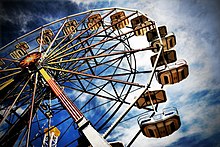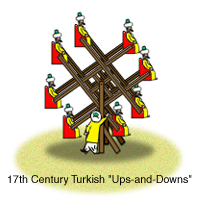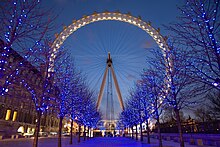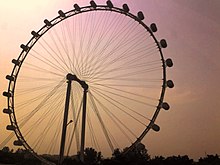Ferris wheel

A Ferris wheel (also known as an observation wheel or big wheel) is a nonbuilding structure, consisting of an upright wheel with passenger gondolas attached to the rim.
The original Ferris wheel was designed by George Washington Gale Ferris, Jr., as a landmark for the 1893 World's Columbian Exposition in Chicago. The name later came to be used generically for all such rides.
Ferris wheels are typically found in amusement parks and funfairs, although since the opening of the London Eye, both permanent or portable Ferris Wheels are increasingly to be found in city centres, as stand alone landmark attractions.[citation needed]
History


The Ferris wheel is named after George Washington Gale Ferris, Jr.. He graduated from Rensselaer Polytechnic Institute and he was a Pittsburgh, Pennsylvania bridge-builder. He began his career in the railroad industry and then pursued an interest in bridge building. Ferris understood the growing need for structural steel and founded G.W.G. Ferris & Co. in Pittsburgh, a firm that tested and inspected metals for railroads and bridge builders.
Ferris designed and built the first 264 foot (80 m) wheel for the World's Columbian Exposition in Chicago, Illinois in 1893. The wheel was intended as a rival to the Eiffel Tower, the centerpiece of the 1889 Paris Exposition. This first wheel could carry 2,160 persons. The Ferris wheel was the largest attraction at the Columbian Exposition, standing over 250' tall and powered by two steam engines. There were 36 cars, accommodating 60 people each (40 seated, 20 standing). It took 20 minutes for the wheel to make two revolutions—the first to make six stops to allow passengers to exit and enter; the 2nd, a single non-stop revolution—and for that, the ticket holder paid 50 cents. When the Exposition ended, the Ferris Wheel was moved to Chicago's north side, next to an exclusive neighborhood. William D. Boyce filed an unsuccessful Circuit Court action against the owners of the wheel, to have it moved. It was then used at the St. Louis 1904 World's Fair and eventually destroyed by controlled demolition in 1906.[1] At 70 tons, its axle was the largest steel forging of the time. It was 26 stories tall, only a quarter of the Eiffel Tower's height.[2]
Sections of this Ferris wheel were used to construct a bridge across the Kankakee River, about 45 miles (72 km) south of Chicago, just north of Tefft, Indiana.[3]
The Travels of Peter Mundy, 1608–1667, describes and illustrates "Several sorts of Swinginge used in their Publique rejoyceings att their feast of Biram" in the Ottoman Balkans. Among means "lesse dangerous and troublesome" only for children was a Ferris wheel "like a Craine wheele att Customhowse Key", where the passengers swing on short swings, sometimes sitting, sometimes hanging trapeze fashion. The illustration here is of a different Turkish design, apparently for adults.

Another Ferris wheel, with a height of 65 meters (213 ft), dating back to 1897, is the Riesenrad in Vienna's Prater, in the second district of Leopoldstadt. It was designed by Hubert Cecil Booth.
London, UK had its very own 'Gigantic Wheel' built at Earls Court in 1895, which was modelled on the original one in Chicago. This wheel stayed in service until 1906, by which time it had carried over 2.5 million passengers. It was built by two young Australian engineers, named Adam Gaddelin and Gareth Watson and was the first of over 200 Ferris wheels that they built.
For the 1900 Paris Exposition, a 'Grande Roue', of similar size and design to Ferris', was constructed. It was demolished in 1937. The wheel had 40 cars (as opposed to Chicago's 36), and is clearly visible in photos of the 1900 exhibition.[4]
Double and triple wheels

In the mid to late 1970s, coaster company, Intamin AG, invented a twist on the Ferris wheel. Using long arms to hold the wheels, they created a way to load and unload Ferris wheels more quickly. In 1976, two Sky Whirls opened, at Marriott's Great America theme parks, in Illinois and California and were the first triple wheels. Triple wheels were attached to three long arms, mounted equal distance in a circle on a central tower. When loading/unloading passengers, the 3 arms would rotate, until one arm was at the loading area and hydraulics would bring that arm/wheel to the ground.
A two-arm version, titled "Zodiac", was also installed at Kings Island in Ohio, as well as at Hersheypark in Pennsylvania, titled "Giant Wheel." The double wheels were attached to a long, straight arm. The arm was mounted in the center, on a central tower. When the hydraulics lowered one side, the other raised. The Kings Island Zodiac was relocated to Australia's Wonderland, but closed in 2004.
All models featured cages, holding eight to ten passengers. The cages were attached to the wheels by chains. When the wheel was in the loading position, it was horizontal and all cages could be loaded at once. As the arm raised or rotated, the wheel moved to a vertical position and provided a typical Ferris-wheel ride, only much higher from the ground.
Another version of this ride existed at Magic Mountain in California titled "Galaxy." This ride was similar to the Zodiac, except the arms did not raise as far off the ground. The arms on this ride were shaped more in a "V", than a straight line and the central tower was shorter. On each wheel were four smaller wheels that also rotated, providing a double vertical rotating movement.
A fourth version of the ride was installed and removed at Astroworld in Texas, titled "Morowheel". It was also similar to the Zodiac model, but had the shorter tower/"V" arm configuration of the Galaxy.
Observation wheels

Some operators prefer the term observation wheel, to Ferris wheel and large Ferris wheels are sometimes marketed as observation wheels, to differentiate them from smaller Ferris wheels; however, the two are actually the same and any distinction between the two names is at the discretion of the wheel operator. Ironically, many of the wheels whose owners reject the term Ferris wheel, actually have more in common with the original Chicago Ferris wheel of 1893, particularly in terms of being an iconic landmark for a city or event.
The world's tallest wheel, the Singapore Flyer, is described as an observation wheel by its operators.[5]
The London Eye, (world's tallest, 1999-2006), is also described as an observation wheel by its operators.[6]
The Star of Nanchang, (world's tallest, 2006-2008), is usually referred to as a Ferris wheel and less commonly, as an observation wheel.
The Southern Star is described by its operators as "the only observation wheel in the southern hemisphere"[7] but also as a Ferris wheel by the media.[8][9]
World's tallest Ferris wheel installations

The world's tallest Ferris wheel is the Singapore Flyer, in Singapore. It is 165 metres (541 ft) high. It started rotating on February 11, 2008 and officially opened to the public on March 1, 2008.
The Star of Nanchang, in Nanchang, Jiangxi Province, China, previously held the record. It is 160 metres (520 ft) high and opened for business in May 2006.
The preceding record holder was the London Eye, in London, UK. It is 135 metres (443 ft) high and is still the largest in the Western Hemisphere.[10] It was officially opened (by Tony Blair) on December 31, 1999, but did not open to the public until March 2000, because of technical problems.
The Shanghai Star, initially planned as a 200 metres (660 ft) tall wheel to be built by 2005, was revised to 170 metres (560 ft), with a completion date set in 2007, but then cancelled in 2006 due to "political incorrectness"[11].
A 198 metres (650 ft) wheel, the Baghdad Eye, has been proposed for a, as yet undetermined, site in Baghdad, Iraq.[12]
A 185 metres (607 ft) wheel, the Great Dubai Wheel, has been proposed for Dubailand, in Dubai, United Arab Emirates.[13]
A 122 metres (400 ft) wheel, the Great Orlando Wheel, has been proposed for Orlando, Florida.[14]
| Name | Height (m) | Year of completion | Country | Location | Remarks |
|---|---|---|---|---|---|
| Beijing Great Wheel | 208 | 2009 | China | Beijing | Under construction |
| Great Berlin Wheel | 185 | 2009 | Germany | Berlin | Under construction |
| Singapore Flyer | 165 | 2008 | Singapore | Singapore | Currently the world's largest wheel |
| Star of Nanchang | 160 | 2006 | China | Nanchang | |
| London Eye | 135 | 1999 | UK | London | |
| The Southern Star | 120 | 2008 | Australia | Melbourne | Under construction |
| Changsha Ferris Wheel [citation needed] | 120 | 2004 | China | Changsha | |
| Zhengzhou Ferris Wheel [citation needed] | 120 | 2003 | China | Zhengzhou | |
| Sky Dream Fukuoka | 120 | 2002 | Japan | Fukuoka | |
| Diamonds and Flowers (daiya & hana) Ferris Wheel [citation needed] | 117 | 2001 | Japan | Kasai Rinkai Park, Edogawa, Tokyo | |
| Sky Wheel [citation needed] | 115 | 1999 | Japan | Palette Town, Odaiba, Tokyo | |
| Star of Tai Lake [citation needed] | 115 | 2008 | China | Wuxi, Jiangsu | |
| Cosmo Clock 21 [15] | 112.5 | 1999 | Japan | Cosmoworld, Yokohama | |
| Tempozan Harbor Village Ferris wheel | 112.5 | 1997 | Japan | Osaka | |
| Harbin Ferris Wheel [citation needed] | 110 | 2003 | China | Harbin | |
| Jinjiang Park Ferris Wheel [citation needed] | 108 | 2002 | China | Shanghai | |
| HEP Five | 106 | 1998 | Japan | Osaka | |
| Ferris Wheel of Paris | 100 | 1900 | France | Paris | Built in 1900 for world exhibition; demolished in 1937 |
| Space Eye [citation needed] | 100 | ? | Japan | Kita-Kyushu | |
| The Great Wheel[16] | 94 | 1895 | UK | Earls Court, London | Demolished 1907 |
| Aurora [17] | 90 | ? | Japan | Nagashima Spa Land, Mie | |
| Eurowheel [citation needed] | 90 | 1999 | Italy | Mirabilandia amusement park, Savio | Europe's second tallest Ferris wheel |
| Janfusun FancyWorld [citation needed] | 88 | ? | Taiwan | Yunlin | |
| Mashhad Fun Fair [citation needed] | 80 | 2001? | Iran | Mashhad | Biggest wheel in Iran |
| The Ferris Wheel [citation needed] | 80 | 1893 | USA | Chicago | First-ever Ferris wheel; built for World's Columbian Exposition (World's Fair); demolished |
| Moscow-850 [citation needed] | 75 | 1995 | Russia | Moscow | Built for 850 jubilee of Moscow foundation celebrated in 1997 |
| Polaris Tower[citation needed] | 72 | 1993 | South Korea | Daejon | |
| Miramar Entertainment Park | 70 | 2002 | Taiwan | Taipei | Including the building it stands on it is 100 m tall |
| Texas Star | 65 | 1985 | USA | Dallas/Fair Park | Largest Ferris wheel in North America |
| Riesenrad Vienna | 64.8 | 1897 | Austria | Vienna | |
| Shining Flower [18] | 61.4 | ? | Japan | Yomiuriland, Inagi |
More Ferris wheels and manufacturers

- The Great Wheel Corporation
- Allan Herschell Company
- Seattle Wheel — has 15 cars with up to two people per car.
- Eli Bridge [6]
- Eagle Wheel - 16 cars with up to three people per car.
- Hy #5 Big Eli Wheel — some are cable driven, others are rim driven. Has 12 cars with up to three people per car.
- Little Wheel — much smaller in dimensions, but it still has 12 cars with up to two people per car.
- Ronald Bussink Professional Rides (formerly Nauta Bussink) [7]
- R60 - 60 meter wheel with 42 enclosed capsules with air conditioning. The largest transportable Ferris wheel in the world. Seen in Germany (Dresden), Malaysia (Kuala Lumpur), Spain (Seville), UK (Belfast, Birmingham, London, Manchester, York) and elsewhere. It requires at least twenty 40 ft (12 m) containers to transport it and is ballasted with water.
- Chance Morgan
- Astro Wheel - 16 cars (8 facing one way, 8 facing the other way) with up to two people per car.
- Century Wheel - 15 cars with up to four people per car.
- Giant Wheel - 20 cars with up to six people per car. This is one of the biggest production Ferris wheels, and requires at least two 18-wheelers to transport it.
- Sky Wheel — a double wheel. There is a wheel on top, and bottom of the ride. There are eight cars per each wheel with up to two people for each car.
- Intamin AG
- Mickey's Fun Wheel - this type of Ferris wheel is a little different. Some of the 16 cars move on a track in the middle of the wheel. There are also 8 cars on the outside of the ride, that do not move much and do not have a track. One of these is located at Disney's California Adventure and another is located at Coney Island. Each car can hold up to six people.
- Roger Wadkins (formerly Bob Childress — Expo Wheels LLC)
- Expo Wheel - 16 cars with up to two people per car. The seating on this wheel is much like the Eli Bridge Hy #5, or Chance's Astro Wheel.
Ferris wheels in popular culture
- The hero of Robert Lawson's children's book The Great Wheel is part of the construction crew for the original Ferris wheel.
- The TV show Carnivàle deals with a circus in 1930's, which has its Ferris wheel as an important symbol. This plays an important role in the series finale.
- The main character from Stargate Atlantis, John Sheppard, likes Ferris wheels.
- The Ferris wheel Riesenrad (in Vienna, Austria) is the stage for a key scene in the 1949 film noir The Third Man. It is also featured in the 1987 James Bond film, The Living Daylights, and appears in the 1995 Richard Linklater film Before Sunrise.
See also
Notes
- ^ Petterchak 2003, pp. 17–18
- ^ Erik Larson. (2003) The Devil in the White City, page 258.
- ^ Joe McKennon (1972) A Pictorial History of the American Carnival, page 39.
- ^ Hyde Park Historical Society -Ferris wheel followup article
- ^ [1] "We don't use the F-word"
- ^ [2] "Is it a Ferris wheel?"
- ^ [3] "welcome to the Southern Star"
- ^ [4] "Work to spin Ferris wheel"
- ^ [5] "Southern Star Observation Wheel profile"
- ^ LeRoy Ashby, "Review of Ferris Whels: An Illustrated History," The Historian 69.3 (Fall, 2007): 603–604.
- ^ Asia Times Online :: China Business News - China's ill-conceived image projects
- ^ Baghdad plans to build giant Ferris wheel
- ^ Ferris wheels grow to new heights to attract the daring
- ^ Developer to roll out plans for Great Orlando Wheel attraction
- ^ コスモクロック21
- ^ ""Great Wheel, Earls Court CC97/01620"".
- ^ http://www.nagashima-onsen.co.jp/file/resortguide_e1.pdf
- ^ ""Yomiuriland"".
References
- Petterchak, Janice A. (2003), Lone Scout: W. D. Boyce and American Boy Scouting, Rochester, Illinois: Legacy Press, ISBN 0965319873
